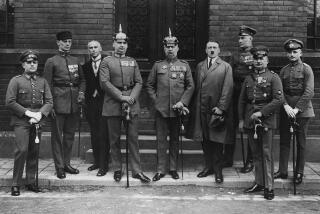THE HITLER OF HISTORY By John Lukacs, Alfred A. Knopf: 280 pp., $26
George Steiner, an astute analyst of culture in the aftermath of the death camps, once said that the Holocaust does everything to the victims, but it does some things to the perpetrators as well. One thing it has done to the German people is to leave them grasping futilely for a coherent way to come to terms with the history that produced Hitler. It would be going too far to call the German historians, who have grappled with this impossible legacy, subsidiary victims of Hitler. But none have escaped damage when attempting the impossible task of explaining Hitler to themselves and to their countrymen. And many have damaged themselves trying to explain him away.
No one sees this more clearly than John Lukacs, a thoughtful and prolific historian who is the author of an illuminating study of the Hitler-Churchill relationship, “The Duel.” In his new work, “The Hitler of History,” he surveys the universe of Hitler historians and scholarship with particular attention to German historians and offers new reflections of his own on the enigmatic psychological evolution of Hitler.
Lukacs finds that, despite the widespread opprobrium some German thinkers evoked in the mid-1980s during what was known as the Historiskerstreit (“the Historians’ battle”), the impulse to rationalize, relativize and normalize Hitler and the Hitler period persists.
In a scathing chapter called “Admirers and Defenders, Open and Hidden,” Lukacs exposes fairly shocking abuses of historical truth by some of Germany’s most respected historians. What makes Lukacs’ findings all the more alarming is the fact that the abuses do not come from fringe or neo-Nazi types but from mainstream makers of contemporary German historical consciousness. He finds repeatedly, beneath the guise of objective analysis, sly and overt attempts “to exonerate at least partially” Hitler and the German nation from responsibility for the war and genocide.
These attempts can take a number of forms. There are those German historians who argue, for instance, that it wasn’t Hitler but the Allies who should be held responsible for starting World II by emphasizing the alleged “warlike purposes of Hitler’s enemies and their supposed rigid unwillingness to compromise, particularly the Poles and Britain.” It is a claim that will come as a surprise to those who consider the British and French peace-at-any-price appeasement of Hitler responsible for the perils of the Poles in the first place and who wonder how the Poles could have compromised with the Blitzkrieg tanks that Hitler sent across their border in September 1939.
Then there are those German historians who attempt to exonerate or excuse Hitler for his biggest, perhaps most fatal blunder (fatal not only to him but to tens of millions of victims), the attack on Russia. Using what Lukacs calls “very questionable documentation,” they argue that “Stalin was about to attack Germany in 1941” and that Hitler had “no choice” but to launch the assault that became a cover for the execution of genocide. (The invading armies were followed by the mobile killing squads that began the work of exterminating the 3 million more Jews that the invasion placed at Hitler’s disposal, work completed by death camps like Auschwitz.)
Stalin is the fulcrum of an even more deeply disingenuous and sweeping explanation of Hitler and the entire Third Reich: that National Socialism and its crimes were a consequence (an “understandable” consequence) of the Bolshevik Revolution and its terror. Or as Ernst Nolte, one contemporary German historian singled out by Lukacs, puts it: “National Socialism was the radical reaction to the victory of the Bolshevik ideology in 1917 in Russia.” That fear of the gulag prison camps supposedly explained and even excused Hitler’s extermination camps as a “defensive” response to “Jewish Bolshevism.” Lukacs does not diminish the genuine horror of the gulag when he says that in some of these rationalizations for Nazi policy, “there is no real distinction between revision and a kind of rehabilitation of Hitler.”
Lukacs has an eagle eye for the etiology of error and the seductions of false logic. His heavily foot-noted obsessiveness, his impassioned concerns about interpretive issues large and small, is testament to a deep sense of dedication to the notion (unfashionable in postmodern academia) that there is such a thing as historical truth, that it can be sought (if not always found) beneath the clash of politicized perspectives.
The urgency of Lukacs’ mission to monitor historical distortion is underscored by the fact that Hitler rode to power on the backs of two powerful and utterly false conceptions of history. The first and most obvious was “The Protocols of the Elders of Zion,” the “evidence” of a sinister Jewish conspiracy counterfeited by the anti-Semitic czarist secret police. The second was the more subtle and insidious “stab in the back” myth, an equally counterfeit version of history, the one that claimed that the German army didn’t really lose World War I on the field of battle but was treacherously stabbed in the back by Jews and Marxists on the home front. It’s disturbing, to say the least, to read Lukacs’ accounts of similar distortions continuing to be perpetrated by the chroniclers of the perpetrator nation.
Not all German historians, of course; Lukacs recognizes the contributions of earlier figures like Ernst Deuerlein and contemporaries like Eberhard Jackel, who was one of the first to blow the whistle on the distortions of the Historiskerstreit rehabilitationists. There are those who are willing to face the consequences and the crimes of the Hitler era unflinchingly. But Lukacs’ pessimism about the politicizing of truth inheres in his assessment of the nature of the divide among German historians: a rift that unfortunately recapitulates the division in the German polity during the Weimar period between the liberals and the nationalists--and we know the outcome of that. Truth about the past became prisoner to the distortions of power and propaganda.
One source of the illegitimate distortions may well be the genuine uncertainty and ambiguity, the legitimate debate surrounding the meaning of Hitler and his place in history. Although I value the service Lukacs has done in historicizing the historians and in offering many provocative, opinionated, sometimes combative reflections on Hitler and Hitler historians, I found myself, as an admirer of the talent for historical narrative he displayed in “The Duel,” particularly impressed by a long chapter in which he ventures into history and historical narrative himself, rather than meta-level historiography.
It’s a chapter in which he reconsiders one of the most hotly debated issues: how to construct a narrative of Hitler’s inner evolution. Lukacs ventures a new assertion about the timing and nature of that evolution, an assertion that departs from the conventional literature on the subject. It is a conjecture focusing upon what some might call the moment of Hitler’s metamorphosis, what Lukacs calls the point of Hitler’s “crystallization,” the point at which, one might say, Hitler became Hitler.
The understandable tendency in most postwar Hitler studies (as Don DeLillo dubbed the field in “White Noise”), has been to seek an early rather than a later date for the inception of Hitler’s fanaticism, for the origin of his anti-Semitism and his genocidal mission. It is understandable that, considering the magnitude of his crimes, many historians insist they must have been a long time in gestation, and most are reluctant to believe that Hitler became Hitler virtually overnight. But explanations that posit early origins have their problems. The psychoanalytically oriented “psychohistorical school,” which emerged in the 1970s, sought a perverse deformation in Hitler’s infantile experience, of course, in disturbances in his psychosexual relationship with his mother, which some theorize was exacerbated by a putative missing testicle or a primal scene of sorts.
Another far-fetched strain of explanation has sought the answer even earlier than Hitler’s infancy by looking two generations before Hitler’s birth at the controversy over the identity of Hitler’s paternal grandfather, who may have--the evidence is hotly disputed--caused Hitler to be doubtful or at least self-conscious about his own racial purity.
But most have sought the moment of metamorphosis in Hitler’s Austrian youth, in the shadowy circumstances and mysterious companions of his down-and-out period in Vienna from 1907, after his mother’s death, to 1913, when he crossed the border to Munich, perhaps to escape the Austrian army draft. Vienna is where Hitler himself located his transformation, which is as good as any reason to question the theory. There are other reasons as well, one of them being that for years after he left Vienna, and particularly in his four years of World War I service in the German army, there is almost no convincing evidence or testimony that Hitler displayed the kind of fanaticism that he would suddenly manifest in the final months of 1919 when he joined the Nazi Party. Of course, one could conceive of him as a time bomb with a long Vienna-lit fuse waiting for ignition.
The problem with these attempts to find a single moment of metamorphosis, some singular deformation of his personality, is the objection Daniel Goldhagen implicitly raises in “Hitler’s Willing Executioners”: The search for some factor that made Hitler “abnormal,” radically different from “ordinary Germans,” is misguided because the hatred he displayed, Hitler’s “eliminationist anti-Semitism,” was in Goldhagen’s view the norm among Germans since the late 19th century. (One puzzling aspect of Lukacs’ book is the absence of any comment on the Goldhagen book, which appeared more than a year and half before his.)
In any case, few historians place the transformative moment in Hitler’s consciousness later than November 1918, during a strange interlude in a military sanitarium in Pomerania when he was in the grip of hysterical blindness, a hallucinatory vision or a full-blown nervous breakdown (accounts on this differ as they do on almost all crucial moments in Hitler’s biography). It is a moment when many historians (such as the late Lucy Davidowicz in her powerful study “The War Against the Jews”) believe Hitler reacted to the sudden shattering news of the German army surrender by conceiving a mission to avenge the “stab in the back” on the internal enemies (Jews and Marxists) he blamed for the German defeat.
But Lukacs builds on some tantalizing new evidence unearthed in the last few years and upon his own thoughtful meditations about personality and historical causality. He attempts to make the case that the moment of transformation came some six months later, in Munich, most probably during the crucial interval between April and September 1919. It’s a conjecture that is about more than just a different month and year; it’s about a different Hitler. The fragmentary findings were dug up by German researchers. One of them, A. Joachimsthaler, found, in previously ignored archives, evidence of Hitler’s apparent allegiance to the Social Democratic regime in Munich at the time. Another, Guido Knopp, even discovered a remarkable piece of newsreel footage (not relied upon by Lukacs) that shows a figure closely resembling Hitler seeming to be taking part--as a designated military mourner--in the funeral parade for Kurt Eisner, the assassinated Jewish socialist head of the post-Armistice Munich regime.
Hitler mourning a Jewish socialist? That was in February 1919, and it’s possible to explain his presence in the detachment of troops wearing the red armbands of socialist sympathizers by assuming he was “following orders” or perhaps serving in an undercover capacity for nationalist elements in the military (a role he’s known to have played several months later, when he attended his first meeting of what would become the National Socialist Party).
But Lukacs seems to believe that if Hitler was not actually in sympathy with the Jewish socialists at that time, he may not yet have been galvanized by the conviction that they were the Mortal Enemy that needed to be exterminated. He tentatively suggests, “It is at least possible . . . that what crystallized these ideas [Hitler’s implacable hatred of Jews and Marxists]” came a few months later when the socialist regime was replaced briefly by a hard-line communist one. What “crystallized” Hitler’s hatred was “[h]is witnessing of the ridiculous and sordid episode of the Munich Soviet Republic with its Jewish and lumpen intellectuals et al.”
Lukacs’ conjecture about this “crystallization” will undoubtedly be debated for many years. It raises disturbing questions. There are those who could misinterpret it to echo, if not corroborate, the German historians Lukacs criticizes for trying to shift the blame for Hitler’s crimes to Stalin and the Bolsheviks. It could be misinterpreted to make it seem that the bloody but ineffectual Jewish Bolsheviks of April 1919 in Munich were responsible somehow for “creating,” or at least catalyzing, Hitler.
But what is perhaps more disturbing is that Lukacs’ conjecture leaves us with a Hitler who doesn’t match the array of Hitlers other earnest historical explainers have given us; it leaves us with a Hitler we’re utterly unfamiliar with. We see a Hitler who was, if not an empty vessel, a man without settled convictions, ambitions or hatred until just a few moments before he stepped upon the world stage as a hate-filled, utterly possessed public figure. It leaves us without a coherent picture of the evolution of the private Hitler (not that we had one before Lukacs’ crystallization conjecture). But here the time for Hitler’s psychological evolution from ineffectual bohemian and failed artist-slacker to raging charismatic Fuhrer collapses into a matter of a few months.
It’s just one further indication of the legacy of doubt--not just of how Hitler could become Hitler, but how anyone could become Hitler--he has left us. It is one more example of how, if he didn’t escape to Argentina, he has still eluded capture in a realm of ambiguity and uncertainty.


